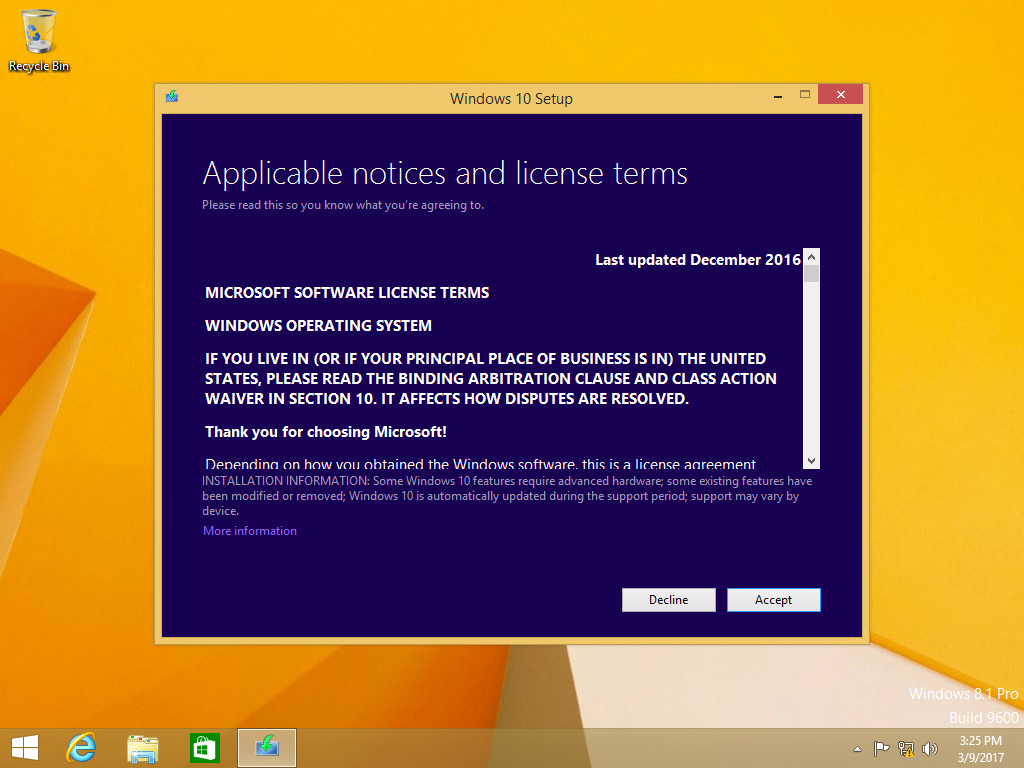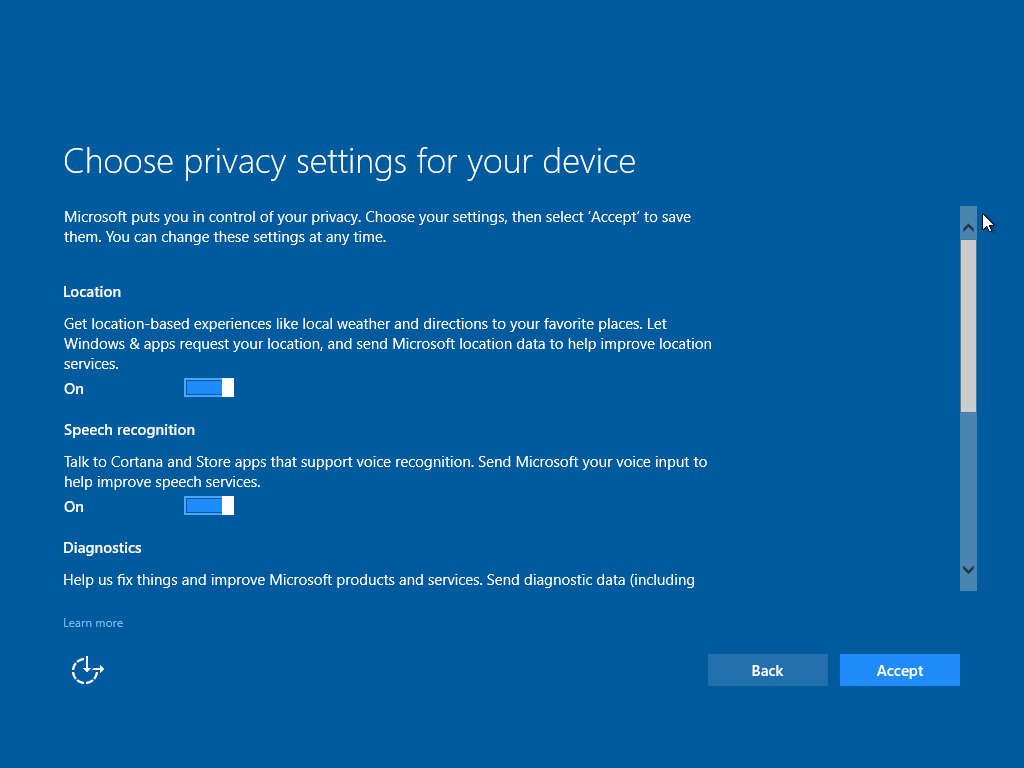NOTE: If your computer has a Intel Clover Trail processor, its not compatible with Windows 10 1809, 1803, 1709 or 1703. Those computers should continue to use Windows 10 1607, which will continue to receive support until January 2023.
Please be sure to follow me on Twitter @adacosta for the latest tips, tricks and updates in the world of Windows 10. -
Technical Level : Basic
Summary
In 2012, Microsoft released Windows 8; subsequent updates such as Windows 8.1 and Windows 8.1 with Update 1 improved the usability of the operating system. Windows 8 was originally imagined as a release targeting a new generation of users in a mobile centric world. With the release of Windows 10 in 2015, much of the theory around Windows 8 has been refined into a practical collection of experiences; embracing proven functionality such as keyboard and mouse input, infused with modern interaction.
While Windows 8’s success in the market place is debatable, the operating system is still in use on millions of systems. If you have been waiting to take the plunge and upgrade to Windows 10, the latest feature updates will be a perfect starting point. If you previously used Windows 7, a lot of similar functionality has been restored: Start menu, task bar and floating apps. In this article, we look at upgrading to latest Windows 10 feature update.
Details
For users running previous version of Windows such as Windows 8 or Windows 8.1, you will need to purchase a license for the Windows 10, if you did not take advantage of the free upgrade offer. You might still qualify for the free upgrade through several channels. See links to resources:
Windows 10 Free Upgrade Still Available
If you are running Windows 7 or a version of Windows 10, see the following:
- How to Upgrade to Windows 10 Creators Update version 1809 using ISO File from Versions 1507, 1511, 1607, 1709 and 1803
- How
to Upgrade to Windows 10 Creators Update version 1809 or Earlier Versions from Windows 7
Windows 10 Feature Updates are a part of Microsoft’s ongoing strategy to deliver Windows as a service.
How to get the Windows 10 Creators Update ISO.
The Media Creation Tool will be updated so you can download the latest version ISO containing the Windows 10 feature update. To learn more about how to download the ISO file, check out the following article:
How to download official Windows 10 ISO files
How to create a bootable copy of the Windows 10 feature update ISO.
Before you can use the Windows 10 feature update ISO, you need to initialize it. Whether you choose to burn to a blank DVD or copy the install files to an empty USB thumb drive. Learn how to do it:
How to Prepare Bootable Install Media for Windows 10 - DVD, USB or SD Card
For troubleshooting instructions, please scroll down further.
Starting the Upgrade
Computers running either Windows 8.0, Windows 8.1 or Windows 8.1 Update 1 can upgrade to the Windows 10. Systems running Windows 8.0 or Windows 8.1 will need to use the ISO to perform an off line upgrade, since the Media Creation Tool is not compatible with those releases. If you are running Windows 8.0, you will need to reinstall all your universal applications from the Store.
Before we begin, launch the Desktop app.
At the desktop, insert your Windows 10 Spring Creators Update install media or if you downloaded the ISO file, double click it or right click the ISO, click Open with then click File Explorer. If setup does not start automatically, click File Explorer on the Taskbar, This PC, double click the setup icon for your install media containing the Windows 10 Spring Creators Update install files.
Wait while setup begins.
You can select download and install any important updates before upgrading. This is recommended since it can help to ensure a smooth upgrade. If you are not connected to the Internet, select the Not right now radio box instead. Click Next.
Wait while Windows 10 setup checks your system for compatibility issues.
If your Windows 8 installation is not activated, you will need to enter a valid Windows 10 key; a Windows 8 key will not work. If you don't have a valid Windows 10 key, then you will have to boot from the Windows 10 install media (DVD or USB), then perform a clean install, skip when prompted to enter a product key, then activate using your Windows 8 product key after reaching the desktop. If you have your Windows 8 product key, try activating your installation first, then restart setup.

Wait while Windows 10 setup does one final check to ensure your system is ready.
Windows 10 setup will check if you have enough disk space. If you don’t, review the following article for instructions how to upgrade to Windows 10 Creators Update on a system with limited space:
How to Upgrade to Windows 10 Feature Update on a Drive with Limited Space
Note, you have the option of choosing what you would like to keep, which includes personal files, apps and settings.
If you want to perform a new install or just keep your files click Change what to keep. Once you have chosen the desired options, click Install to begin.
To learn more about performing a clean install: How to: Perform a clean install of Windows 10
This will be your screen for a little while. During the installation, your computer will restart several times.
After the first restart, Windows 10 setup will resume. You will notice the setup experience has once again been refined from the previous animated circle. This will be your screen for a while. When complete, Windows 10 setup will restart automatically.
Users upgrading from Windows 7, will have a few more steps to complete before reaching the desktop. Click Next, to sign in.
Here, you can adjust your privacy settings. This will let you choose what you want Windows 10 to know about you. You can accept the defaults or take your time and review them. Click the toggle button to turn on/off a setting. You can also make changes at anytime after reaching the desktop, click Start > Settings > Privacy.
Cortana is the new digital assistant built into Windows 10 that helps you do all sorts of things like: track package, find information on the web and your PC, find the name of a song playing, tell a joke, create a reminder or schedule an appointment. Cortana is not required, but it makes Windows 10 a unique experience.
Windows 10 comes built in with a new generation of programs called universal apps. These apps can do many things like manage your images (Photos); buy, listen and stream music (Groove); buy, watch, TV and movies (Movies & TV); browse the web safely, ask questions, write on web pages and enhance with extensions (Edge). You can change the defaults here and anytime in Windows 10. Click Next to continue.
Sign into your account.
Wait while Windows 10 completes application updates and post setup tasks.
That’s it, the Windows 10 Spring Creators Update is installed.You can check Windows Update for latest updates, click Start > Settings > Update & security > Windows Update > Check for Updates.
How to prepare your computer before upgrading?
Although updating to a new Windows 10 version is a relatively simple process, similar to a repair upgrade; users should perform some basic pre-requisites before initiating the upgrade.
If you are finding it difficult to carry out some of the steps described below, please review detailed instructions how to perform them:
12 Things You Should Do Before Installing Windows 10
When making significant changes to your computer such as updating the operating system, you should always backup.
-
Disable (preferrably uninstall) your Antivirus utility before attempting the upgrade.
-
Restart a few times then try again.
-
Disable General USB Devices (example - Smart Card Reader). You can do this from the Device Manager.
-
If you have any external devices attached to the machine, disconnect them (example, gaming controllers, USB keys, external hard disk, printers, non-essential devices).
-
Load your BIOS the reset the BIOS defaults.
-
Check if there are any available BIOS updates for your system, then apply them.
-
Perform a clean boot, restart then try again.
-
If you are upgrading using the .ISO file, disconnect from the Internet during setup, if you are connected by LAN (Ethernet) or Wi-Fi, disable both then attempt setup again.
-
If you are updating through Windows Update, when the download reaches 100% disconnect from the Internet LAN (Ethernet) or Wi-Fi then proceed with the installation.
-
If that does not work, try using the .ISO file to upgrade if possible.
-
If you are connected to a domain, switch to a local account or upgrade based on your System Administrators discretion.




















